ignition MERCEDES-BENZ E-CLASS ESTATE 2015 Owners Manual
[x] Cancel search | Manufacturer: MERCEDES-BENZ, Model Year: 2015, Model line: E-CLASS ESTATE, Model: MERCEDES-BENZ E-CLASS ESTATE 2015Pages: 497, PDF Size: 16.23 MB
Page 17 of 497
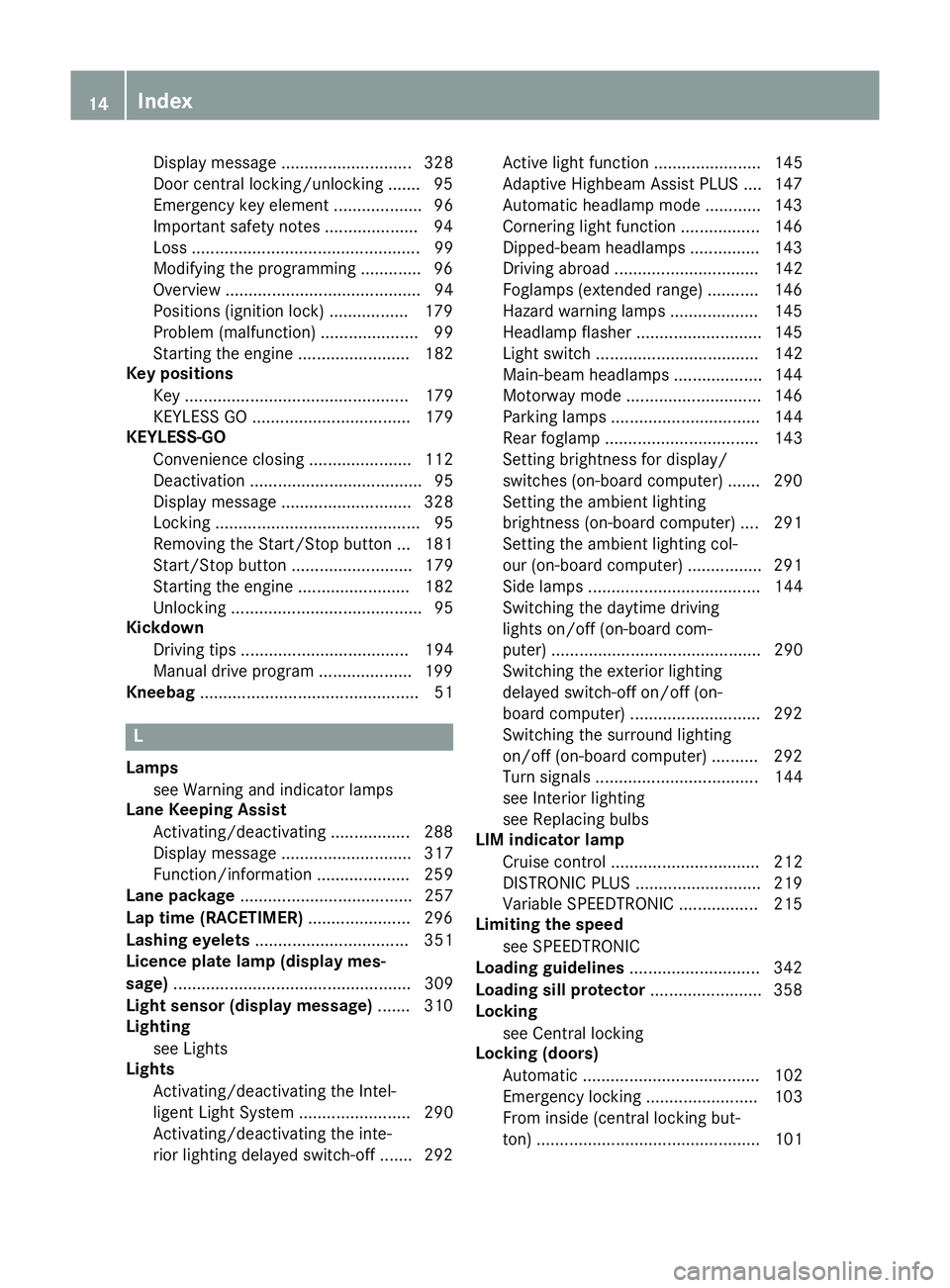
Display message ............................ 328
Doo rcentral locking/unlocking ....... 95
Emergency key element ................... 96
Important safety note s.................... 94
Los s................................................. 99
Modifying the programming ............. 96
Overview .......................................... 94
Positions (ignition lock) ................. 179
Problem (malfunction) ..................... 99
Starting the engine ........................ 182
Ke yp ositions
Key ................................................ 179
KEYLESS GO .................................. 179
KEYLESS-GO
Convenience closing ...................... 112
Deactivation ..................................... 95
Displa ymessage ............................ 328
Locking ............................................ 95
Removing the Start/Sto pbutton ... 181
Start/Sto pbutton .......................... 179
Starting the engine ........................ 182
Unlocking ......................................... 95
Kickdown
Driving tip s.................................... 194
Manua ldrive progra m.................... 199
Kneebag ............................................... 51 L
Lamps see Warning and indicator lamps
Lan eKeeping Assist
Activating/deactivating ................. 288
Displa ymessage ............................ 317
Function/information .................... 259
Lan epackage ..................................... 257
Lap time (RACETIMER) ...................... 296
Lashin geyelets ................................. 351
Licenc eplate lamp (display mes-
sage) ................................................... 309
Light senso r(display message) ....... 310
Lighting
see Lights
Lights
Activating/deactivating the Intel-
ligent Light System ........................ 290
Activating/deactivating the inte-
rio rlighting delaye dswitch-off ....... 292 Active light function ....................... 145
Adaptive Highbeam Assist PLU
S.... 147
Automati cheadlamp mod e............ 143
Cornering light function ................. 146
Dipped-bea mheadlamp s............... 143
Driving abroa d............................... 142
Foglamp s(extende drange) ........... 146
Hazard warning lamps ................... 145
Headlamp flashe r........................... 145
Light switch ................................... 142
Main-bea mheadlamp s................... 144
Motorwa ymode............................. 146
Parking lamps ................................ 144
Rear foglamp ................................. 143
Setting brightness for display/
switche s(on -board computer) ....... 290
Setting the ambient lighting
brightness (on-board computer) .... 291
Setting the ambient lighting col-
ou r(on -board computer) ................ 291
Sid elam ps ..................................... 144
Switching the daytime driving
lights on/of f(on -board com-
puter) ............................................. 290
Switching the exterio rlighting
delaye dswitch-off on/of f(on-
board computer) ............................ 292
Switching the surround lighting
on/of f(on -board computer) .......... 292
Turn signal s................................... 144
see Interior lighting
see Replacing bulbs
LI Mi ndicator lamp
Cruise control ................................ 212
DISTRONIC PLU S........................... 219
Variabl eSPEEDTRONIC ................. 215
Limiting the speed
see SPEEDTRONIC
Loadin gguidelines ............................ 342
Loadin gsillp rotector ........................ 358
Locking
see Central locking
Locking (doors)
Automati c...................................... 102
Emergency locking ........................ 103
From inside (central locking but-
ton) ................................................ 101 14
Index
Page 35 of 497
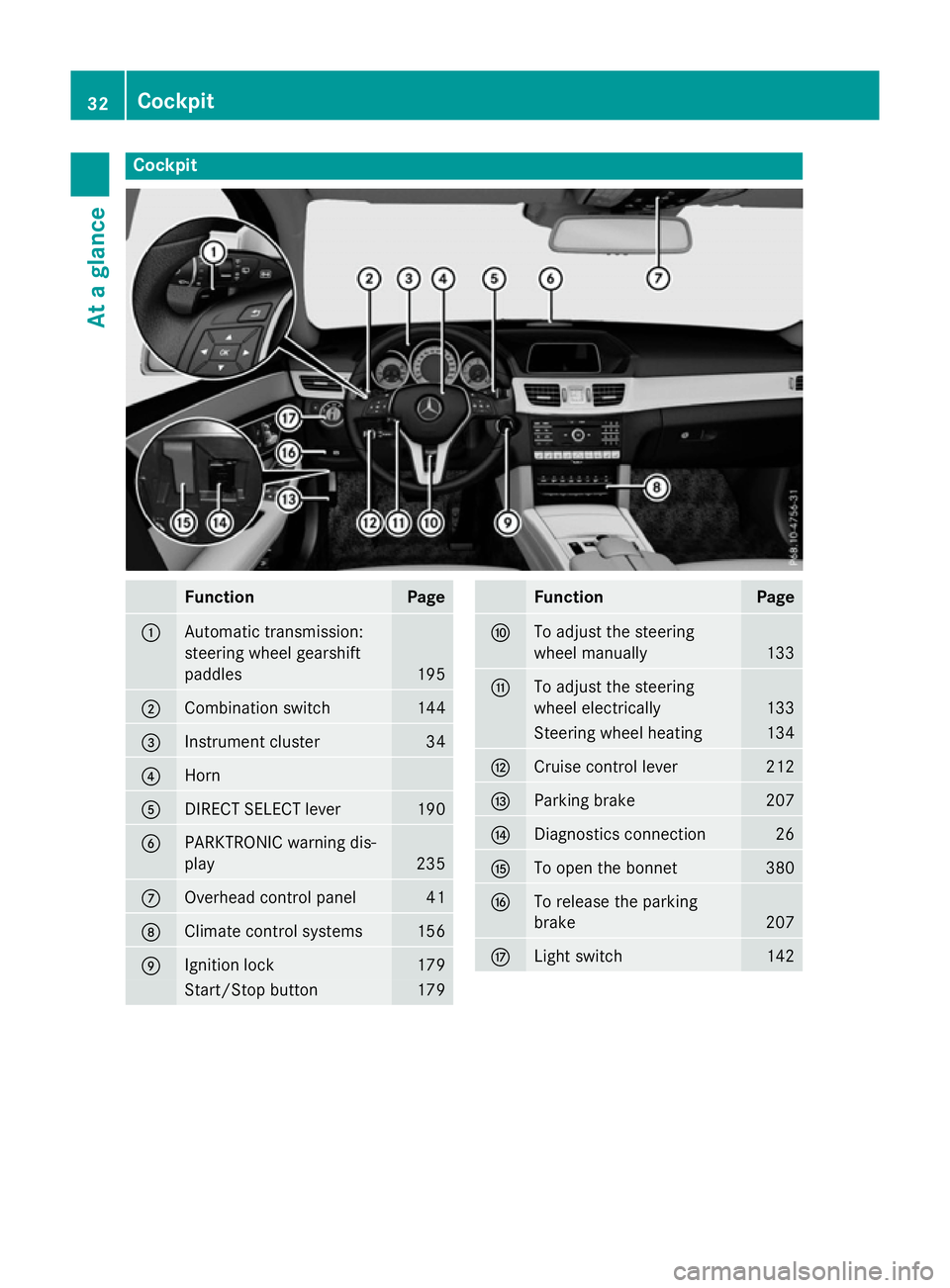
Cockpit
Function Page
:
Automatic transmission:
steering wheel gearshift
paddles
195
;
Combination switch 144
=
Instrumen
tcluster 34
?
Horn
A
DIRECT SELECT lever 190
B
PARKTRONIC warning dis-
play
235
C
Overhead control panel 41
D
Climat
econtro lsystems 156
E
Ignition lock 179
Start/Sto
pbutton 179 Function Page
F
To adjust th
esteering
wheel manually 133
G
To adjust th
esteering
wheel electrically 133
Steering wheel heating 134
H
Cruise control lever 212
I
Parking brake 207
J
Diagnostics connection 26
K
To open th
ebonnet 380
L
To release th
eparking
brake 207
M
Ligh
tswitch 14232
CockpitAt
ag lance
Page 36 of 497
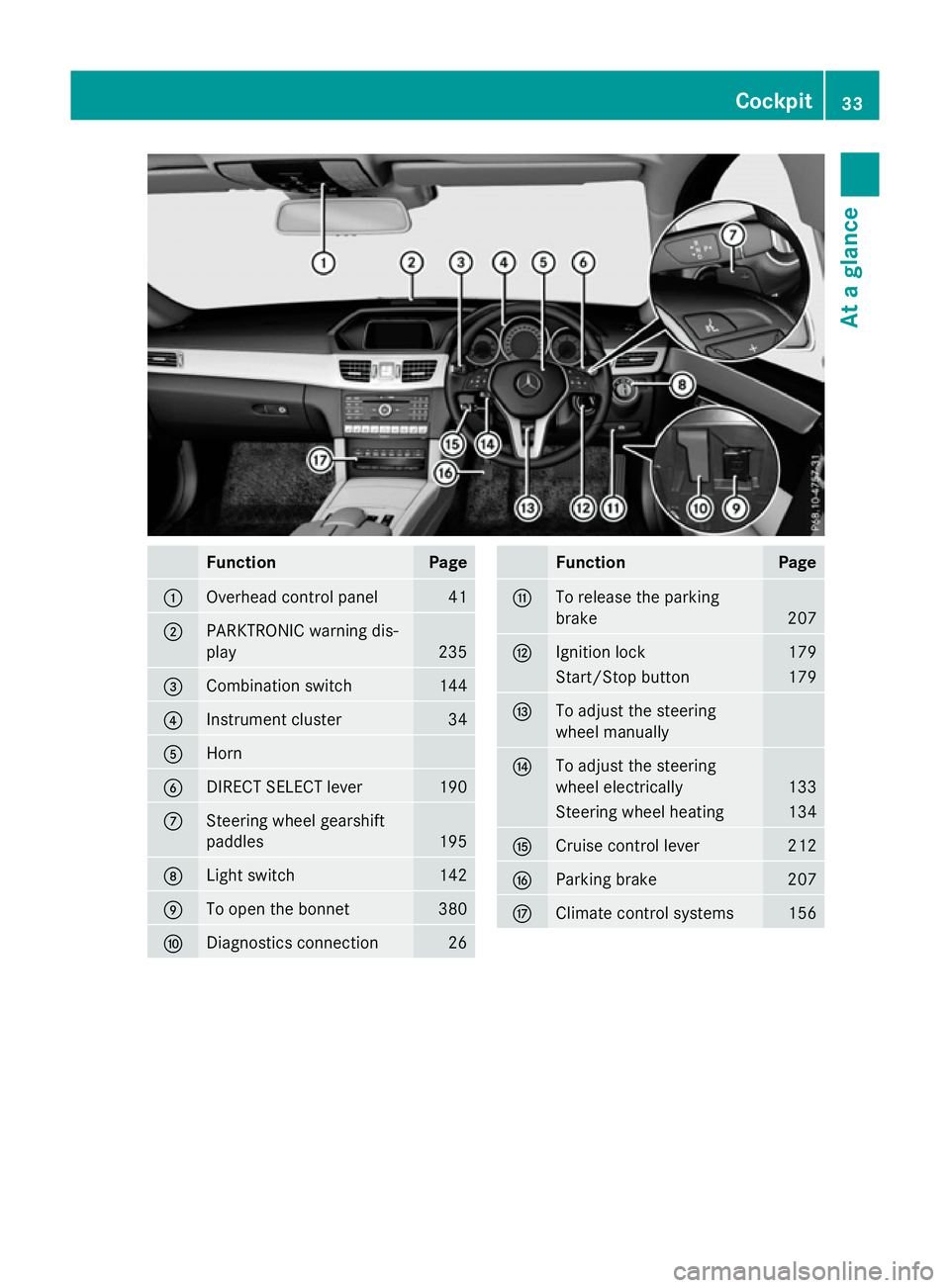
Function Page
:
Overhead control panel 41
;
PARKTRONIC warning dis-
play 235
=
Combination switch 144
?
Instrumen
tcluster 34
A
Horn
B
DIRECT SELECT lever 190
C
Steering wheel gearshift
paddles
195
D
Ligh
tswitch 142
E
To open th
ebonnet 380
F
Diagnostics connection 26 Function Page
G
To release th
eparking
brake 207
H
Ignition lock 179
Start/Sto
pbutton 179
I
To adjust th
esteering
wheel manually J
To adjust th
esteering
wheel electrically 133
Steering wheel heating 134
K
Cruis
econtro llever 212
L
Parking brake 207
M
Climat
econtro lsystems 156Cockpit
33Atag lance
Page 47 of 497
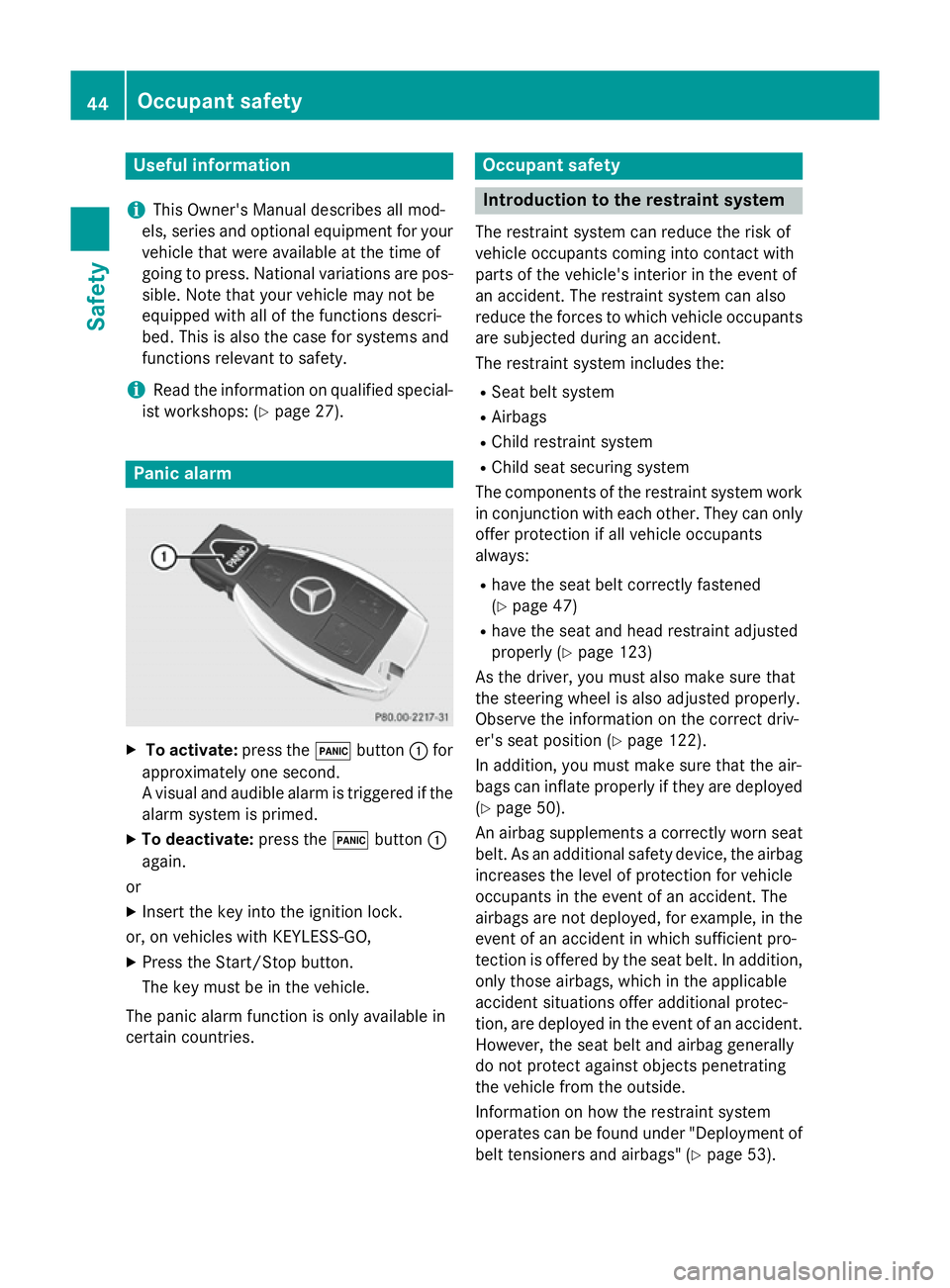
Useful information
i This Owner's Manual describes all mod-
els, series and optional equipment for your
vehicle that were available at the time of
going to press. National variation sare pos-
sible. Not ethat your vehicle may not be
equipped with all of the function sdescri-
bed. This is also the case for system sand
function srelevan ttosafety.
i Read the information on qualified special-
ist workshops: (Y page 27). Panic alarm
X
To activate: press the!button :for
approximately one second.
Av isual and audible alarm is triggered if the
alarm system is primed.
X To deactivate: press the!button :
again.
or X Insert the key int othe ignition lock.
or, on vehicles with KEYLESS‑GO, X Press the Start/Stop button.
The key must be in the vehicle.
The panic alarm function is only available in
certain countries. Occupant safety
Introduction to the restraint system
The restraint system can reduce the risk of
vehicle occupants comin gintoc ontact with
parts of the vehicle' sinterior in the even tof
an accident. The restraint system can also
reduce the forces to which vehicle occupants
are subjected during an accident.
The restraint system includes the:
R Seat belt system
R Airbags
R Child restraint system
R Child seat securin gsystem
The components of the restraint system work
in conjunction with each other .They can only
offer protection if all vehicle occupants
always:
R have the seat belt correctly fastened
(Y page 47)
R have the seat and head restraint adjusted
properly (Y page 123)
As the driver, you must also make sure that
the steering wheel is also adjusted properly.
Observ ethe information on the correct driv-
er's seat position (Y page 122).
In addition ,you must make sure that the air-
bags can inflat eproperly if they are deployed
(Y page 50).
An airbag supplement sacorrectly worn seat
belt. As an additional safet ydevice, the airbag
increases the level of protection for vehicle
occupants in the even tofanaccident. The
airbags are not deployed, for example, in the even tofana ccidentinwhich sufficient pro-
tection is offered by the seat belt. In addition,
only thos eairbags, which in the applicable
acciden tsituation soffer additional protec-
tion ,are deployed in the even tofanaccident.
However ,the seat belt and airbag generally
do not protect against objects penetrating
the vehicle from the outside.
Information on how the restraint system
operates can be found under "Deploymen tof
belt tensioner sand airbags" (Y page 53).44
Occupant safetySafety
Page 48 of 497
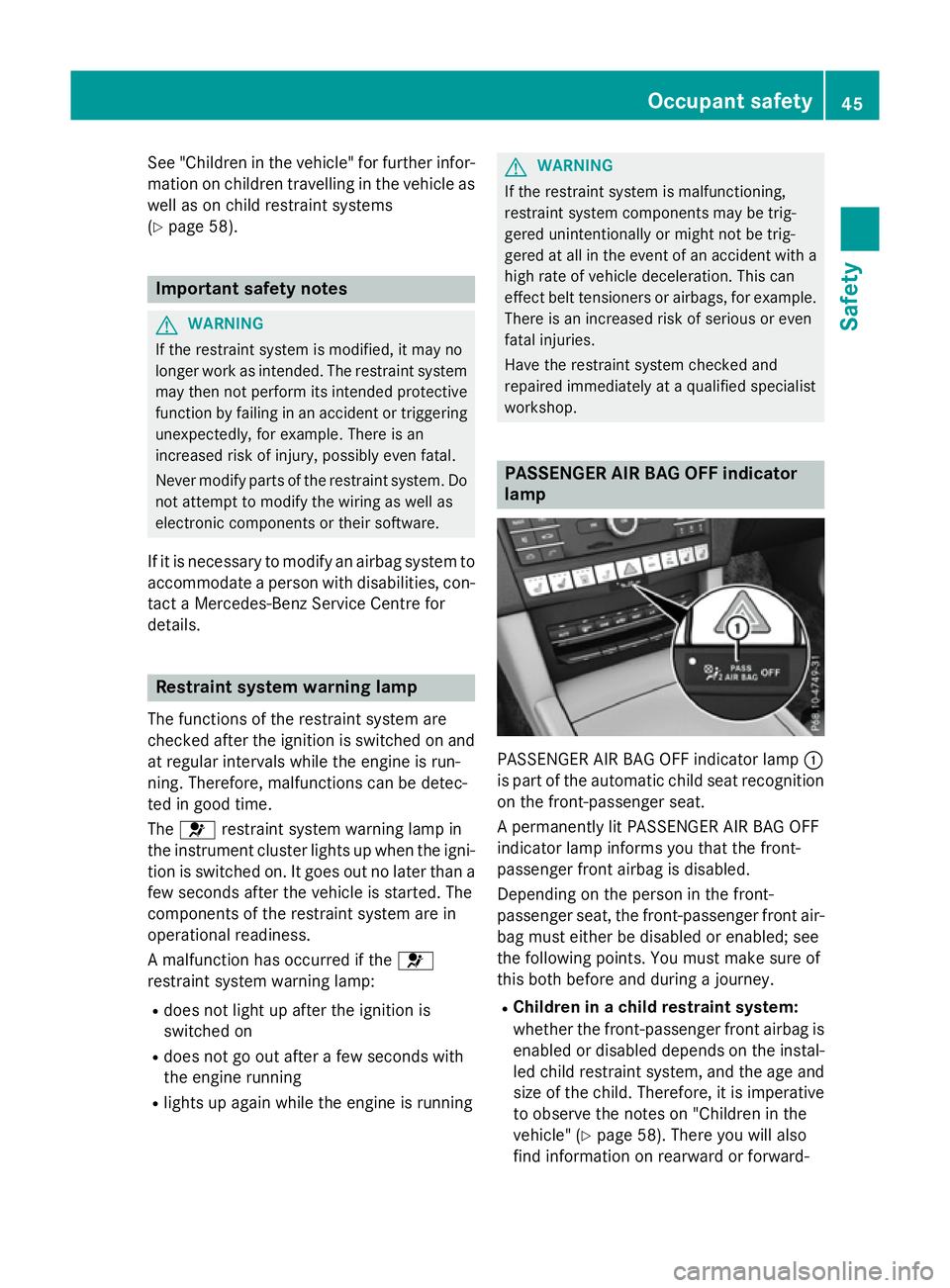
See "Children in the vehicle" for further infor-
mation on children travelling in the vehicl eas
well as on child restraint systems
(Y page 58). Important safety notes
G
WARNING
If the restraint system is modified ,itmay no
longer work as intended .The restraint system
may then not perfor mits intended protective
function by failing in an accident or triggering
unexpectedly, for example. There is an
increased ris kofinjury ,possibly eve nfatal.
Neve rmodify parts of the restraint system. Do
not attempt to modify the wiring as well as
electronic components or thei rsoftware.
If it is necessary to modify an airba gsystem to
accommodate aperson with disabilities, con-
tact aMercedes-Benz Service Centre for
details. Restrain
tsystem warnin glamp
The functions of the restraint system are
checke dafterthe ignition is switche donand
at regular interval swhile the engine is run-
ning. Therefore, malfunctions can be detec-
ted in goo dtime.
The 6 restraint system warning lamp in
the instrument cluster lights up when the igni- tion is switche don. It goe soutno later tha na
few seconds afte rthe vehicl eisstarted. The
components of the restraint system are in
operationa lreadiness.
Am alfunction ha soccurred if the 6
restraint system warning lamp:
R doe snot light up afte rthe ignition is
switche don
R doe snot go ou tafte raf ew seconds with
the engine running
R lights up agai nwhile the engine is running G
WARNING
If the restraint system is malfunctioning,
restraint system components may be trig-
gered unintentionally or might not be trig-
gered at al linthe event of an accident with a
high rate of vehicl edeceleration. Thi scan
effect belt tensioner sorairbags, for example.
There is an increased ris kofserious or even
fata linjuries.
Hav ethe restraint system checke dand
repaired immediatel yataqualified specialist
workshop. PASSENGER AI
RBAG OF Find icator
lamp PASSENGER AIR BAG OFF indicator lamp
:
is part of the automatic child sea trecognition
on the front-passenger seat.
Ap ermanently li tPASSENGER AIR BAG OFF
indicator lamp informs yo uthatthe front-
passenger front airba gisdisabled.
Depending on the person in the front-
passenger seat, the front-passenger front air-
ba gm uste ither be disabled or enabled ;see
the following points. Yo umustm ake sure of
this both before and during ajourney.
R Childre ninachild restrain tsystem:
whethe rthe front-passenger front airba gis
enabled or disabled depends on the instal- le dc hild restraint system, and the ag eand
size of the child .Therefore, it is imperative
to observe the notes on "Children in the
vehicle" (Y page 58). There yo uwilla lso
find information on rearward or forward- Occupant safety
45Safety Z
Page 52 of 497
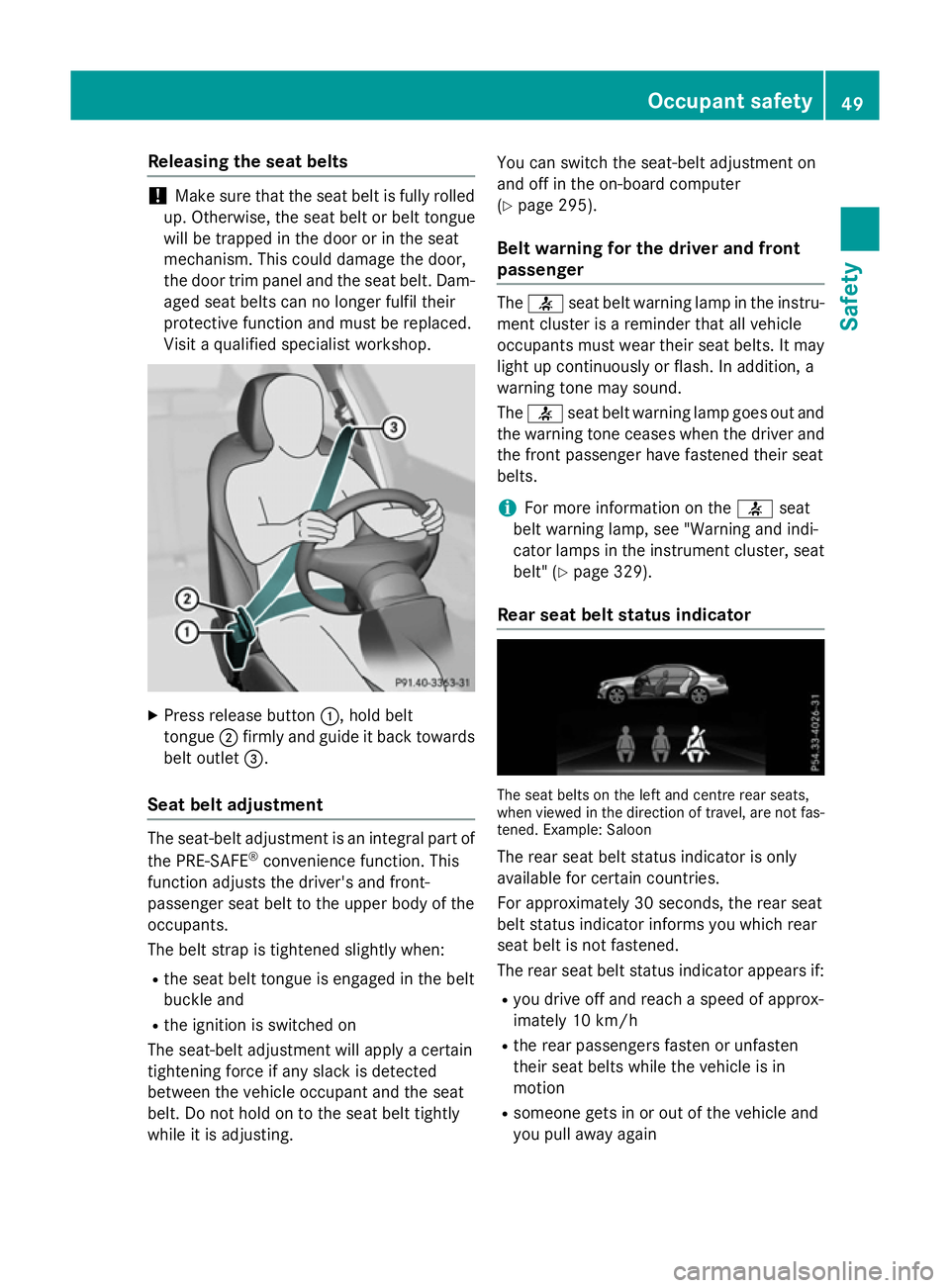
Releasin
gthe seat belts !
Make sure that the sea
tbelti sf ully rolled
up .O therwise, the sea tbeltorb eltt ongue
will be trapped in the doo rorinthe seat
mechanism. Thi scould damag ethe door,
the doo rtrim panel and the sea tbelt. Dam-
aged sea tbelts can no longer fulfil their
protectiv efunction and mus tbereplaced.
Visit aquali fied specialist workshop. X
Press release button :,holdb elt
tongue ;firmly and guid eitbackt owards
bel toutlet =.
Seat belt adjustment The seat-bel
tadjustment is an integral part of
the PRE-SAFE ®
convenience function. This
function adjusts the driver' sand front-
passenger sea tbelttot he upper bod yofthe
occupants.
The bel tstra pist ightened slightl ywhen:
R the sea tbeltt ongu eise ngaged in the belt
buckle and
R the ignition is switche don
The seat-bel tadjustment will appl yacertain
tightening force if any slack is detected
between the vehicl eoccupant and the seat
belt. Do not hol dontothe seatbeltt ightly
whil eitisa djusting. Yo
uc an switch the seat-bel tadjustment on
and off in the on-board computer
(Y page 295).
Bel twarnin gfor the drive rand front
passenger The
7 seatbeltw arning lamp in the instru-
ment cluster is areminder that al lvehicle
occupants mus twearthei rseatb elts. It may
light up continuously or flash. In addition, a
warning tone may sound.
The 7 seatbeltw arning lamp goe soutand
the warning tone ceases when the driver and
the front passenger have fastened thei rseat
belts.
i For more information on the
7seat
bel tw arning lamp, see "Warning and indi-
cato rlam ps in the instrument cluster, seat
belt" (Y page 329).
Rear seat belt status indicator The sea
tbelts on the left and centre rea rseats,
when viewe dinthe direction of travel ,are not fas-
tened .Example :Saloon
The rea rseatb elts tatu sindicator is only
available for certain countries.
For approximately 30 seconds ,the rea rseat
bel tstatu sindicator informs yo uwhich rear
sea tbelti sn ot fastened.
The rea rseatb elts tatu sindicator appears if:
R yo ud rive off and reach aspeed of approx-
imately 10 km/h
R the rea rpassenger sfasten or unfasten
thei rseatb elts whil ethe vehicl eisin
motion
R someone gets in or ou tofthe vehicl eand
yo up ulla wa ya gain Occupan
tsafety
49Safety Z
Page 56 of 497
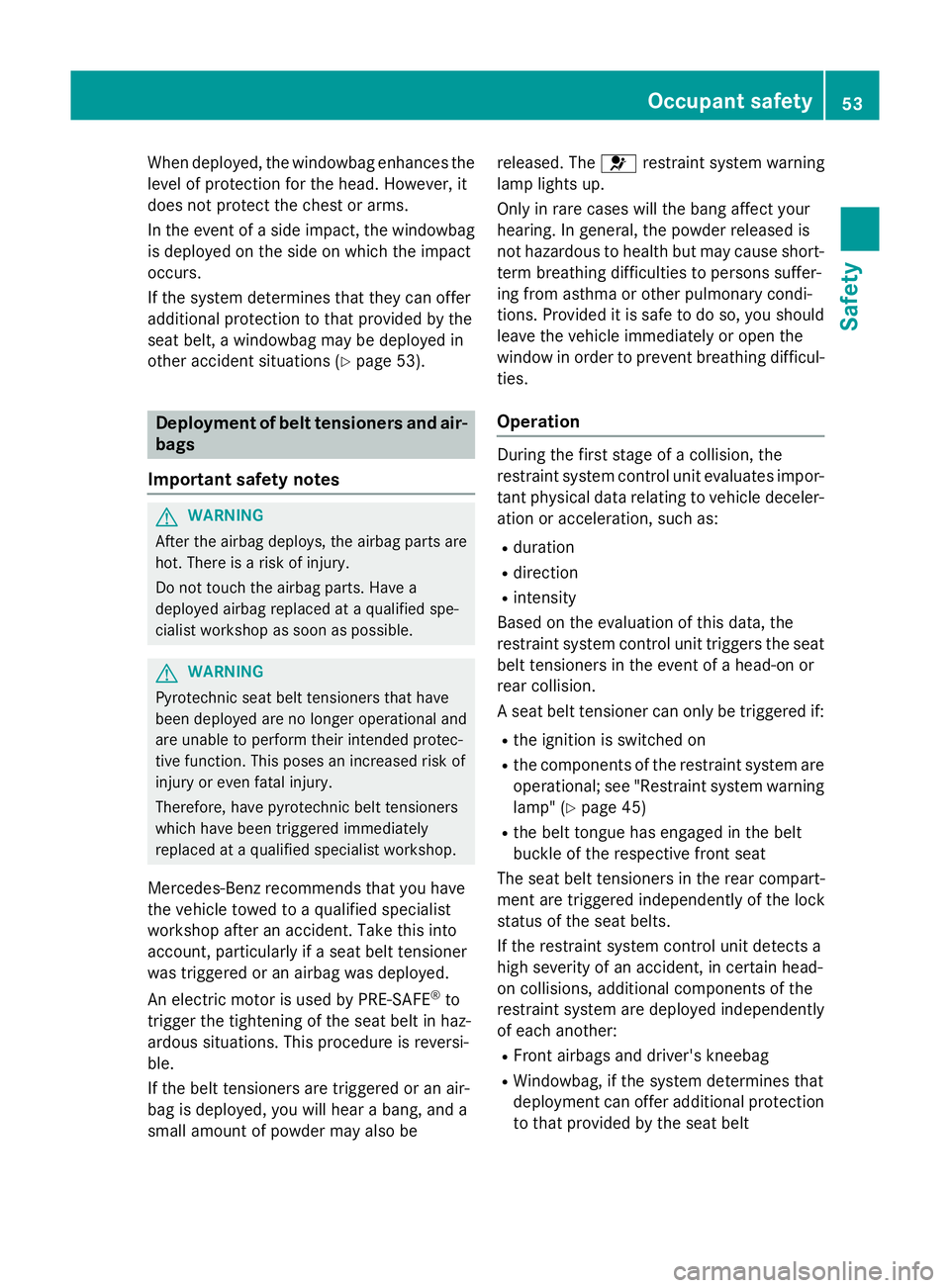
When deployed, the windowbag enhances the
level of protection for the head. However, it
does not protec tthe chest or arms.
In the event of aside impact, the windowbag
is deployed on the side on which the impact
occurs.
If the system determines that they can offer
additional protection to that provided by the
seat belt, awindowbag may be deployed in
other accident situation s(Ypage 53). Deployment of belt tensioners and air-
bags
Important safety notes G
WARNING
After the airbag deploys, the airbag parts are
hot. There is arisk of injury.
Do not touch the airbag parts. Have a
deployed airbag replaced at aqualified spe-
cialist workshop as soon as possible. G
WARNING
Pyrotechnic seat belt tensioners that have
been deployed are no longer operational and
are unable to perform their intended protec-
tive function. This poses an increased risk of
injury or even fatal injury.
Therefore, have pyrotechnic belt tensioners
which have been triggered immediately
replaced at aqualified specialist workshop.
Mercedes-Benz recommends that you have
the vehicle towed to aqualified specialist
workshop after an accident .Take this into
account ,particularly if aseat belt tensioner
was triggered or an airbag was deployed.
An electric motor is used by PRE-SAFE ®
to
trigger the tightening of the seat belt in haz-
ardous situations. This procedure is reversi-
ble.
If the belt tensioners are triggered or an air-
bag is deployed, you will hear abang, and a
small amount of powder may also be released. The
6restraint system warning
lamp lights up.
Only in rare cases will the bang affect your
hearing. In general, the powder released is
not hazardous to health but may cause short- term breathin gdifficulties to persons suffer-
ing from asthma or other pulmonary condi-
tions. Provided it is safe to do so, you should
leave the vehicle immediately or open the
window in order to preven tbreathin gdifficul-
ties.
Operation During the first stage of
acollision, the
restraint system control unit evaluates impor-
tant physical data relating to vehicle deceler- ation or acceleration, such as:
R duration
R direction
R intensity
Based on the evaluation of this data, the
restraint system control unit trigger sthe seat
belt tensioners in the event of ahead-on or
rear collision.
As eat belt tensioner can only be triggered if:
R the ignition is switched on
R the componentsoft he restraint system are
operational; see "Restraint system warning lamp" (Y page 45)
R the belt tongue has engaged in the belt
buckle of the respective fron tseat
The seat belt tensioners in the rear compart-
ment are triggered independently of the lock
status of the seat belts.
If the restraint system control unit detect sa
high severit yofanaccident,incertain head-
on collisions, additional componentsoft he
restraint system are deployed independently
of each another:
R Fron tairbags and driver's kneebag
R Windowbag, if the system determines that
deployment can offer additional protection
to that provided by the seat belt Occupant safety
53Safety Z
Page 70 of 497
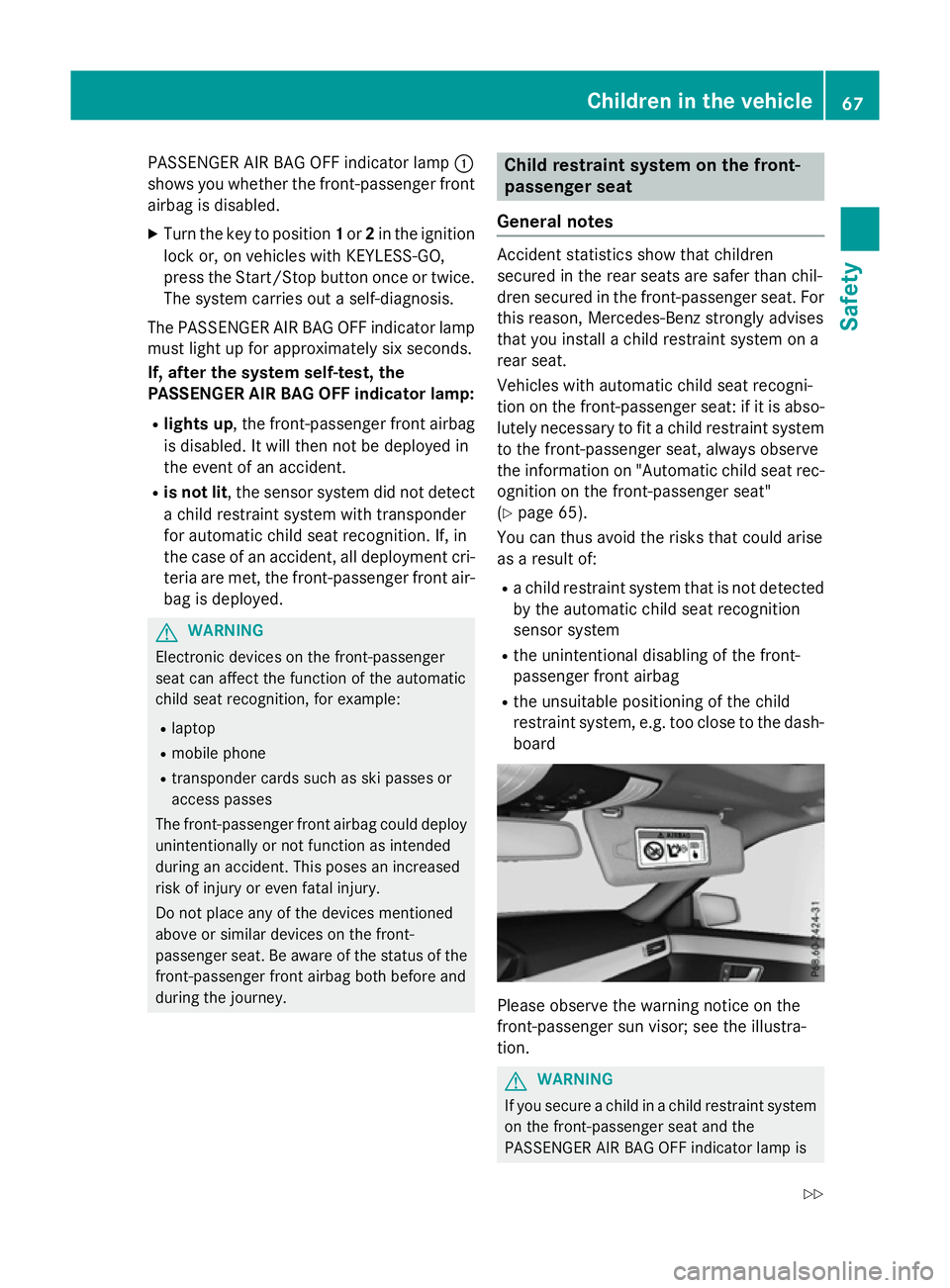
PASSENGERA
IR BAG OFF indicator lamp :
shows you whether the front-passenger front airbag is disabled.
X Turn the key to position 1or 2in the ignition
lock or, on vehicles with KEYLESS-GO,
press the Start/Stop button once or twice. The system carries out aself-diagnosis.
The PASSENGERA IR BAG OFF indicator lamp
must light up for approximately six seconds.
If, after the system self-test, the
PASSENGER AIR BAG OFF indicator lamp:
R lights up ,the front-passenger fronta irbag
is disabled. It will then not be deployed in
the event of an accident.
R is not lit,t he sensor system did not detect
ac hild restraint system with transponder
for automatic child seat recognition. If, in
the case of an accident ,all deployment cri-
teria are met, the front-passenger fronta ir-
bag is deployed. G
WARNING
Electronic devices on the front-passenger
seat can affect the function of the automatic
child seat recognition, for example:
R laptop
R mobile phone
R transponder cards such as ski passes or
access passes
The front-passenger fronta irbag could deploy
unintentionally or not function as intended
during an accident .This poses an increased
risk of injury or even fatal injury.
Do not place any of the devices mentioned
above or similar devices on the front-
passenger seat. Be aware of the status of the front-passenger fronta irbag both before and
during the journey. Child restraint system on the front-
passenger seat
General notes Accident statistics show that children
secured in the rear seats are safer than chil-
dren secured in the front-passenger seat. For
this reason, Mercedes-Benz strongly advises
that you install achild restraint system on a
rear seat.
Vehicles with automatic child seat recogni-
tion on the front-passenger seat: if it is abso- lutely necessary to fit achild restraint system
to the front-passenger seat, alway sobserve
the information on "Automatic child seat rec-
ognition on the front-passenger seat"
(Y page 65).
You can thus avoid the risks that could arise
as aresult of:
R ac hild restraint system that is not detected
by the automatic child seat recognition
sensor system
R the unintentional disabling of the front-
passenger fronta irbag
R the unsuitable positionin gofthe child
restraint system, e.g. too close to the dash-
board Please observe the warning notice on the
front-passenger sun visor; see the illustra-
tion.
G
WARNING
If you secure achild in achild restraint system
on the front-passenger seat and the
PASSENGER AIR BAG OFF indicator lamp is Children in the vehicle
67Safety
Z
Page 71 of 497
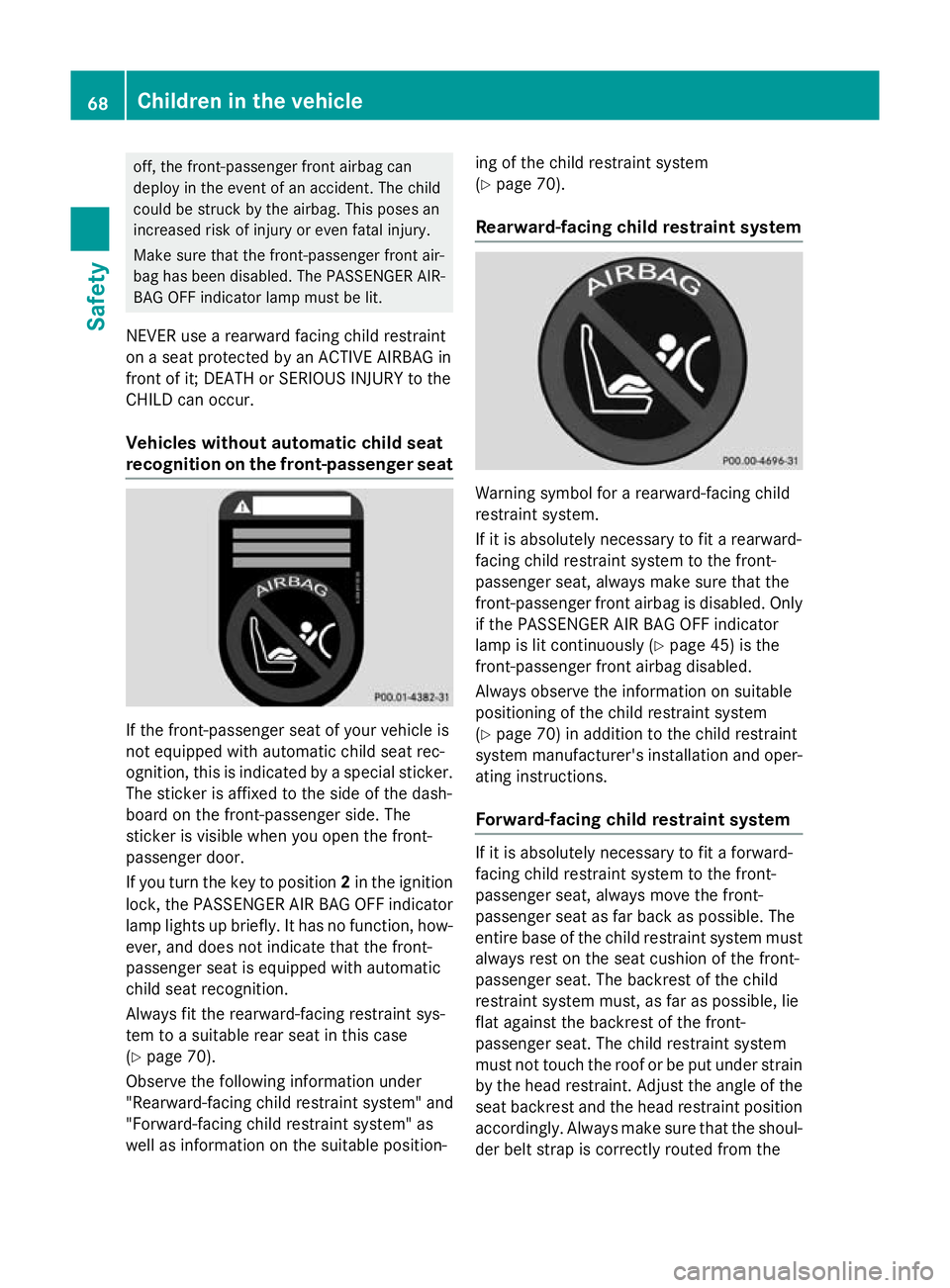
off, the front-passenger front airbag can
deploy in the event of an accident .The child
could be struck by the airbag. This poses an
increased risk of injury or even fatal injury.
Make sure that the front-passenger front air-
bag has been disabled. The PASSENGER AIR- BAG OFF indicator lamp must be lit.
NEVERu searearward facing child restraint
on aseat protected by an ACTIVE AIRBAGin
front of it; DEATH or SERIOUS INJURY to the
CHILD can occur.
Vehicles without automatic child seat
recognition on the front-passenger seat If the front-passenger seat of your vehicle is
not equipped with automatic child seat rec-
ognition
,this is indicated by aspecial sticker.
The sticker is affixed to the side of the dash-
board on the front-passenger side. The
sticker is visible when you open the front-
passenger door.
If you turn the key to position 2in the ignition
lock, the PASSENGER AIR BAG OFF indicator lamp lights up briefly. It has no function, how-ever, and does not indicate that the front-
passenger seat is equipped with automatic
child seat recognition.
Always fit the rearward-facing restraint sys-
tem to asuitable rear seat in this case
(Y page 70).
Observe the following information under
"Rearward-facing child restraint system" and
"Forward-facing child restraint system" as
well as information on the suitable position- ing of the child restraint system
(Y
page 70).
Rearward-facing child restraint system Warning symbol for
arearward-facing child
restraint system.
If it is absolutely necessary to fit arearward-
facing child restraint system to the front-
passenger seat, always make sure that the
front-passenger front airbag is disabled. Only if the PASSENGER AIR BAG OFF indicator
lamp is lit continuously (Y page 45) is the
front-passenger front airbag disabled.
Always observe the information on suitable
positioning of the child restraint system
(Y page 70) in addition to the child restraint
system manufacturer' sinstallation and oper-
ating instructions.
Forward-facing child restraint system If it is absolutely necessary to fit
aforward-
facing child restraint system to the front-
passenger seat, always move the front-
passenger seat as far back as possible. The
entire base of the child restraint system must
always rest on the seat cushion of the front-
passenger seat. The backrest of the child
restraint system must, as far as possible, lie
flat against the backrest of the front-
passenger seat. The child restraint system
must not touch the roof or be put under strain by the head restraint .Adjust the angle of the
seat backrest and the head restraint position accordingly. Always make sure that the shoul-
der belt strap is correctly routed from the 68
Children in the vehicleSafety
Page 73 of 497
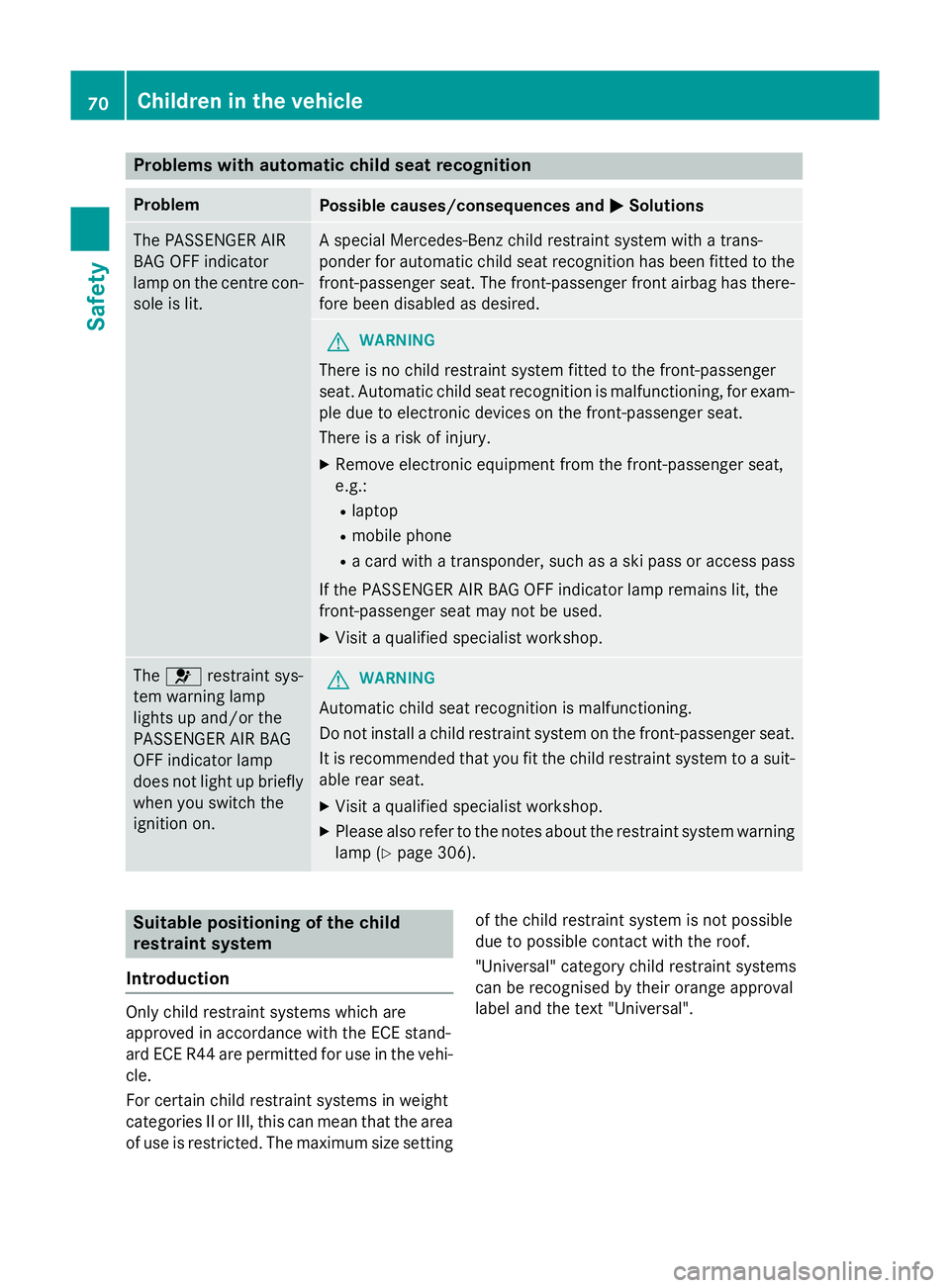
Problems with automatic child seat recognition
Problem
Possible causes/consequences and
M
MSolutions The PASSENGER AIR
BAG OFF indicator
lamp on the centre con-
sole is lit. As
pecial Mercedes-Benz child restraint system with atrans-
ponder for automatic child seat recognition has been fitted to the
front-passenger seat. The front-passenger front airbag has there- fore been disabledasd esired. G
WARNING
There is no child restraint system fitted to the front-passenger
seat. Automatic child seat recognition is malfunctioning, for exam-
ple due to electronic devices on the front-passenger seat.
There is arisk of injury.
X Remove electronic equipment from the front-passenger seat,
e.g.:
R laptop
R mobile phone
R ac ard with atransponder, such as aski pass or access pass
If the PASSENGER AIR BAG OFF indicator lamp remains lit, the
front-passenger seat may not be used.
X Visit aqualified specialist workshop. The
6 restraint sys-
tem warning lamp
lights up and/or the
PASSENGER AIR BAG
OFF indicator lamp
does not light up briefly
when you switch the
ignition on. G
WARNING
Automatic child seat recognition is malfunctioning.
Do not install achild restraint system on the front-passenger seat.
It is recommended that you fit the child restraint system to asuit-
able rear seat.
X Visit aqualified specialist workshop.
X Please also refer to the notes about the restraint system warning
lamp (Y page 306). Suitable positioning of the child
restraint system
Introduction Only child restraint systems which are
approved in accordance with the ECE stand-
ard ECE R44 are permitted for use in the vehi- cle.
For certain child restraint systems in weight
categories II or III, this can mean that the area of use is restricted. The maximum size setting of the child restraint system is not possible
due to possible contact with the roof.
"Universal" category child restraint systems
can be recognised by their orange approval
label and the text "Universal".70
Children in the vehicleSafety